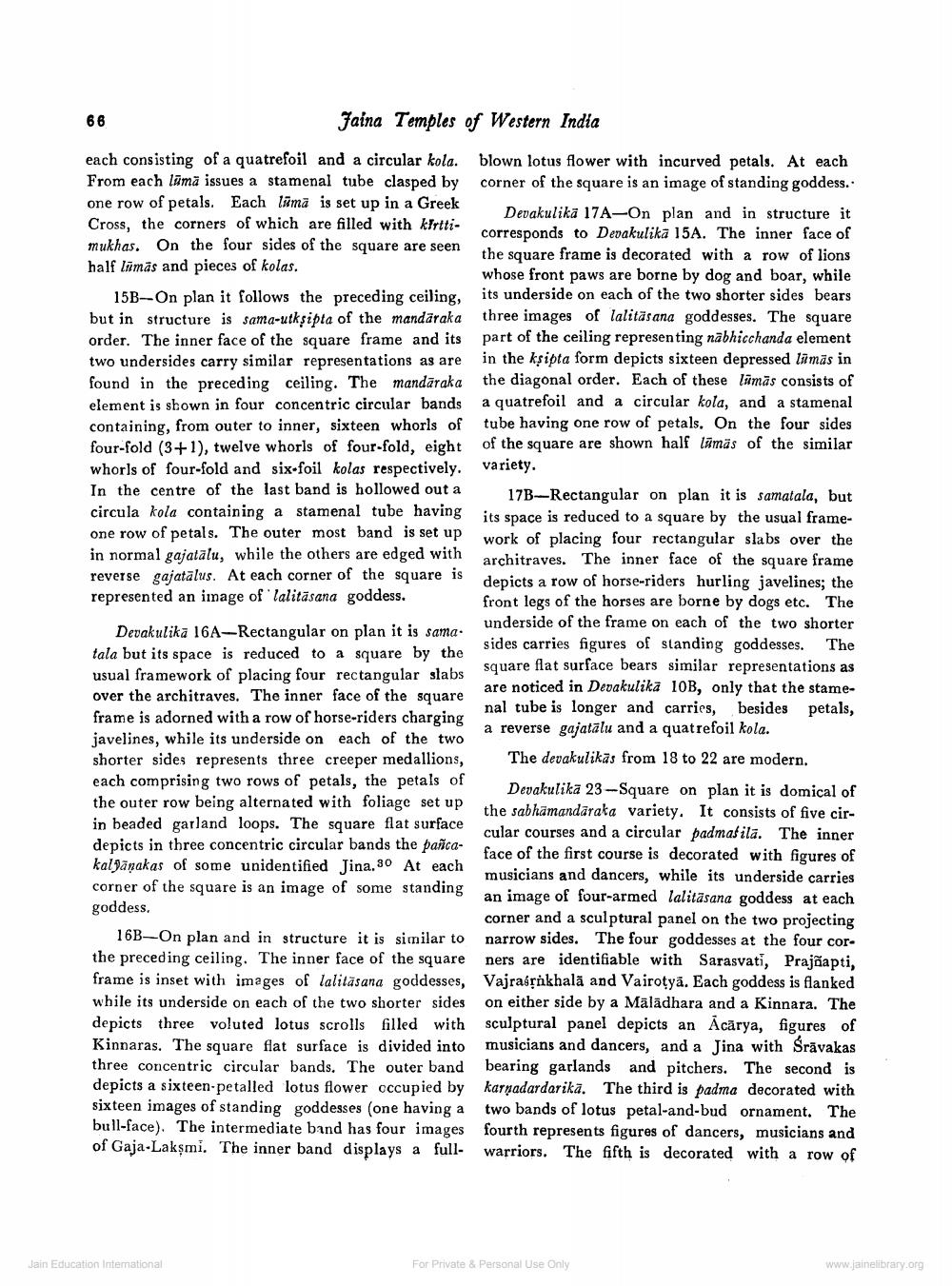________________
66
Faina Temples of Western India
each consisting of a quatrefoil and a circular kola. blown lotus flower with incurved petals. At each From each lūma issues a stamenal tube clasped by corner of the square is an image of standing goddess. one row of petals. Each lima is set up in a Greek
Devakulika 17A-On plan and in structure it Cross, the corners of which are filled with kirtti
corresponds to Devakulika 15A. The inner face of mukhas. On the four sides of the square are seen
the square frame is decorated with a row of lions half lämās and pieces of kolas.
whose front paws are borne by dog and boar, while 15B-On plan it follows the preceding ceiling, its underside on each of the two shorter sides bears but in structure is sama-utksipta of the mandāraka three images of lalitäsana goddesses. The square order. The inner face of the square frame and its part of the ceiling representing nābhicchanda element two undersides carry similar representations as are in the ksipta form depicts sixteen depressed limās in found in the preceding ceiling. The mandāraka the diagonal order. Each of these limās consists of element is shown in four concentric circular bands a quatrefoil and a circular kola, and a stamenal containing, from outer to inner, sixteen whorls of tube having one row of petals. On the four sides four-fold (3+1), twelve whorls of four-fold, eight of the square are shown half lämäs of the similar whorls of four-fold and six-foil kolas respectively. variety. In the centre of the last band is hollowed out a 17B-Rectangular on plan it is samatala, but
its space is reduced to a square by the usual frameone row of petals. The outer most band is set up
work of placing four rectangular slabs over the in normal gajatalu, while the others are edged with
architraves. The inner face of the square frame reverse gajatālus. At each corner of the square is
depicts a row of horse-riders hurling javelines; the represented an image of 'lalitasana goddess.
front legs of the horses are borne by dogs etc. The
underside of the frame on each of the two shorter Devakulika 16A-Rectangular on plan it is sama.
sides carries figures of standing goddesses. The tala but its space is reduced to a square by the usual framework of placing four rectangular slabs
square flat surface bears similar representations as
are noticed in Devakulika 10B, only that the stameover the architraves. The inner face of the square
nal tube is longer and carries, besides petals, frame is adorned with a row of horse-riders charging
a reverse gajatālu and a quatrefoil kola. javelines, while its underside on each of the two shorter sides represents three creeper medallions, The devakulikās from 18 to 22 are modern. each comprising two rows of petals, the petals of
Devakulika 23 --Square on plan it is domical of the outer row being alternated with foliage set up
the sabhāmandāraka variety. It consists of five cirin beaded garland loops. The square flat surface
cular courses and a circular padmašila. The inner depicts in three concentric circular bands the pasica
face of the first course is decorated with figures of kalJāņakas of some unidentified Jina.30 At each
musicians and dancers, while its underside carries corner of the square is an image of some standing
an image of four-armed lalitāsana goddess at each goddess.
corner and a sculptural panel on the two projecting 16B-On plan and in structure it is similar to narrow sides. The four goddesses at the four corthe preceding ceiling. The inner face of the square ners are identifiable with Sarasvati, Prajāapti, frame is inset with images of lalitāsana goddesses, Vajraísnkhalā and Vairotyä. Each goddess is flanked while its underside on each of the two shorter sides on either side by a Maladhara and a Kinnara. The depicts three voluted lotus scrolls filled with sculptural panel depicts an Acārya, figures of Kinnaras. The square flat surface is divided into musicians and dancers, and a Jina with Srāvakas three concentric circular bands. The outer band bearing garlands and pitchers. The second is depicts a sixteen-petalled lotus flower occupied by karnadardarika. The third is padma decorated with sixteen images of standing goddesses (one having a two bands of lotus petal-and-bud ornament. The bull-face). The intermediate band has four images fourth represents figures of dancers, musicians and of Gaja-Lakşmi. The inner band displays a full- warriors. The fifth is decorated with a row of
Jain Education International
For Private & Personal Use Only
www.jainelibrary.org




